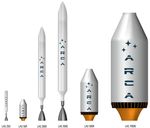LAS, Electric Rocket - ARCA Space Corporation
←
→
Page content transcription
If your browser does not render page correctly, please read the page content below
Press Release: May 1st, 2019
LAS, Electric Rocket
Current rockets are using polluting, explosive, corrosive, toxic,
carcinogenic propellants. At launch, a rocket releases polluting
chemicals into the atmosphere as much as 1 million cars running
simultaneously.
ARCA created an electric, water based rocket that works as first
stage, or booster for launch vehicles, allowing the reduction of
polluting propellant with around 25%, or boost the payload
capability with around 30%, pollution free. Such system isn’t only
clean, but unprecedently safe and cost effective.
But how such engine works?
The rocket tank is filled with 98% water and benign phase
destabilizers. The water is electrically heated to 250°C. When the
water is injected into the engine, part of it flashes into water vapors.
A second heating phase occurs in the engine powered by high
discharge LiPo batteries. The same type of batteries used by ARCA
to power the cutting edge, 700kW ArcaBoard. At 42MW, the amount
of electric energy released during engine run is more than what a small nuclear reactor generates. Solar
and wind power can recharge the rocket’s batteries.
Using water as propellant has another groundbreaking advantage: cost. Decades long efforts of the
industry to reduce launch cost were unsuccessful. The root cause of rocket’s high cost is the type of
propellants and related complexity. They are polluting, volatile, explosive, corrosive, toxic, cryogenic,
carcinogenic, requiring extreme safety measures, complex fabrication and operations. This leads to an
unavoidable result: extremely high costs.
Like early electric cars, an electric rocket
is not as efficient as one using polluting
fuels. But it’s ideal as launch booster, or
first stage, because it’s able to generate
extremely high thrust at launch. ARCA
named it Launch Assist System (LAS).
1The rockets are using the majority of their fuel at take off when they are heavy. LAS can accelerate rockets
to 3,000m and Mach 2, reducing the polluting propellants with 25%, or increase their payload capability
with 30%, using just water and electricity. New, more advanced designs like ARCA’s Haas 2CA Single Stage
to Orbit Rocket will reduce its polluting propellant mass from 16 to 6 tons using 18 tons of water instead.
LAS is built by ARCA in two configurations: an expendable and a fully reusable one. ARCA is currently
testing a 25 tons of thrust expendable version, called LAS 25D, that will be shortly followed by a larger
reusable vehicle, LAS 50R, already under construction.
The current reusable rockets didn’t deliver the expected cost cut and fast turnaround. After each flight
the vehicles need to be extensively checked and refurbished. The components affected by high
temperatures and pressures have to be replaced. Due to benign nature of water, LAS will land, be refueled
from the sea and reused like a true shuttle, providing high frequency launch services, attempting to solve
decades-long efforts to achieve significant cost reduction of orbital launches.
In regards to space tourism, or manned spaceflight in general, current vehicles use polluting propellants.
In terms of safety, what more can a paying space tourist ask for, than water as fuel?
ARCA is considering a heavy orbital rocket launcher, to compete with the most powerful, but also one of
the most polluting rockets: Falcon Heavy and SLS Block 1. Haas Heavy, will be able to put 60 tons into low
earth orbit, while 70% of its total mass will be water.
There are plans from space agencies and companies to use the resources from other planets to produce
the rocket propellants onsite in support for spaceships sent from Earth.
For instance, there are plans to obtain methane from CO2 and liquid oxygen from water through
electrolysis and then liquefaction, on Mars. These are indeed possible, but involves additional equipment
and effort. On the other hand, icy water is abundantly found in the Solar System, on the Moon, Mars,
Europa, Enceladus, Titan, the asteroids, etc. A LAS technology vehicle will just require ice in the tank. The
ice will melt using the onboard resistors. In this way, LAS could become a good choice for a deep space
exploration vehicle since its propellant is abundantly found through the Solar System.
2Without considering potential orders from third parties for the
LAS technology, ARCA will continue with the ground tests of
LAS 25D towards the middle of 2019 and will start the
construction of LAS 50R with the first VTOL flight scheduled for
the fall of 2019.
We will also continue with the development of Haas 2CA
Mini that works in conjunction with LAS 50. The first flight of
Haas 2CA Mini + LAS 50R should be expected for 2020, when
we should also expect the start of commercial services for
small payloads of 200kg to LEO.
The development of Haas 3 + LAS 500R with capabilities of
3000kg to LEO should start in 2021 with the first flight
expected in 2022, followed by the launch of commercial
services in 2023.
The construction start of Haas Heavy + LAS 7000R should be
expected in 2022 with the LAS 7000R VTOL flights performed
in 2023 and the complete vehicle first flight in 2024.
LAS is a stepping stone for a new generation of clean, safe
and affordable rockets.
Read more about the LAS technology in the White Paper:
http://www.arcaspace.com/docs/ARCA_LAS_White_Paper_May_1_2019_Issue_1.pdf
Video - LAS, Electric Rocket: https://youtu.be/zV8j08mCBEs
contact@arcaspace.com
http://www.arcaspace.com
https://www.facebook.com/arcaspace
https://www.youtube.com/user/ARCAchannel
https://twitter.com/arcaspace
3You can also read






















































